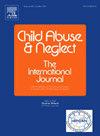“在压力下成长”:家庭压力模型及其在儿童早期和晚期的心理攻击和身体攻击中的作用
IF 3.4
2区 心理学
Q1 FAMILY STUDIES
引用次数: 0
摘要
随着家庭经济压力的加剧,物质困难影响父母行为和孩子结果的途径变得越来越重要。目的建立家庭压力模型(FSM),探讨物质困难、父母加重和邻里效能对儿童虐待风险的综合影响。我们假设这些通路在童年早期和晚期的强度会有所不同。方法采用RStudio软件对未来家庭与儿童健康研究(n = 3830)的第3、6波数据进行多元线性回归分析。结果物质困难显著预测心理攻击(β = 0.20, p <;.001)和身体攻击(β = 0.22, p <;.001),而其影响在儿童期后期减弱,仅对心理攻击保持显著(β = 0.22, p <;措施)。父母加重表现出类似的模式,在儿童早期对两种结果的影响都更强(β = 0.18和β = 0.15, p <;.001),但仅在儿童后期的心理攻击方面保持显著性(β = 0.15, p <;措施)。这些发现扩展了FSM,证明家庭压力的传递在不同的发展阶段有很大的不同,儿童早期是一个高度脆弱的时期。心理攻击在青春期的持久影响,加上身体攻击的减少,揭示了不同形式的虐待是如何遵循与年龄相关的独特模式的——这一发现挑战了传统的“一刀切”的干预方法。因此,我们建议针对发展量身定制的干预措施,既解决眼前的物质需求,又解决父母的压力管理,特别是在这些压力源影响最强的幼儿时期。本文章由计算机程序翻译,如有差异,请以英文原文为准。
“Growing up under pressure”: The family stress model and its role in psychological aggression and physical assault across early and late childhood
Background
As economic pressures on families intensify, the pathways through which material hardship shapes parental behavior and child outcomes become increasingly critical to understand.
Objective
Building upon the Family Stress Model (FSM), we examined the combined influence of material hardship, parental aggravation, and neighborhood efficacy on child maltreatment risks. We hypothesized that these pathways would differ in strength between early and late childhood.
Methods
We conducted multiple linear regression analysis with RStudio using waves 3 and 6 of the Future of Families and Child Wellbeing Study (n = 3830) data.
Results
Material hardship significantly predicted both psychological aggression (β = 0.20, p < .001) and physical assault (β = 0.22, p < .001) in early childhood, while its influence diminished in late childhood, remaining significant only for psychological aggression (β = 0.22, p < .001). Parental aggravation showed similar patterns, with stronger effects in early childhood for both outcomes (β = 0.18 and β = 0.15, respectively, p < .001) but maintaining significance only for psychological aggression in late childhood (β = 0.15, p < .001).
Conclusions
These findings extend the FSM by demonstrating that the transmission of family stress varies substantially across developmental stages, with early childhood emerging as a period of heightened vulnerability. The enduring impact of psychological aggression through adolescence, coupled with declining physical assault, exposes how different forms of maltreatment follow unique age-related patterns - a finding that challenges traditional ‘one-size-fits-all’ interventions approaches. Hence, we suggest developmentally tailored interventions that address both immediate material needs and parental stress management, particularly during early childhood when the impact of these stressors are strongest.
求助全文
通过发布文献求助,成功后即可免费获取论文全文。
去求助
来源期刊

Child Abuse & Neglect
Multiple-
CiteScore
7.40
自引率
10.40%
发文量
397
期刊介绍:
Official Publication of the International Society for Prevention of Child Abuse and Neglect. Child Abuse & Neglect The International Journal, provides an international, multidisciplinary forum on all aspects of child abuse and neglect, with special emphasis on prevention and treatment; the scope extends further to all those aspects of life which either favor or hinder child development. While contributions will primarily be from the fields of psychology, psychiatry, social work, medicine, nursing, law enforcement, legislature, education, and anthropology, the Journal encourages the concerned lay individual and child-oriented advocate organizations to contribute.
 求助内容:
求助内容: 应助结果提醒方式:
应助结果提醒方式:


